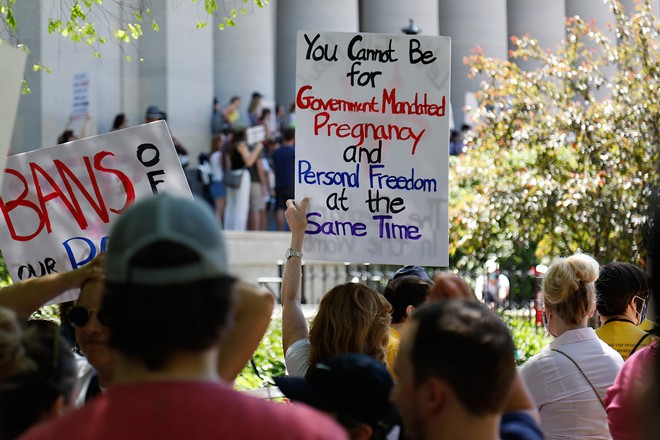
They’ve finished the battle, now it’s time for the war.
That’s the sentiment on both sides of the Issue 1 fight, who have now pledged to come out of the ballot measure’s defeat and move on to the abortion referendum in November. Both, unsurprisingly, expect to come out ahead.
“Whether it’s reproductive rights, voting rights or labor rights, these freedoms should not be subject to the whims of out-of-touch politicians,” U.S. Rep. Emilia Sykes, D-Ohio, said in a Tuesday night statement as Issue 1 headed for defeat. “Tonight we celebrate, but the fight continues in November.”
The unofficial tally showed a resounding rejection of the legislature-proposed amendment to raise the voter threshold to change the Ohio Constitution from 50% + 1 to 60%.
As of Wednesday morning, with all precincts reporting and more than 3.5 million votes entered, 57% of voters cast a “no” vote on the issue, with 43% of voters on the “yes” side.
According to the Ohio Secretary of State’s Office, 58,073 absentee and provisional ballots have yet to be counted, but the rejection of Issue 1 holds an insurmountable 430,000 vote lead.
The Ohio Christian Alliance mentioned this vote deficit in its statement after Issue 1 was defeated, saying opponents of the measure “again used 28 days of early voting to bank the vote against the issue and that margin was just too great to overcome.”
Despite early voting leaning Democratic since the pandemic, Ohio voters of any party can vote early if they so choose.
The defeat of Issue 1 means the status quo continues in Ohio, with no changes to the requirements to approve a constitutional amendment, and signature campaign requirements of 44 of 88 counties in the state remaining as they were before the ballot measure.
“The failure of Issue #1 allows an equal playing field for future proposed constitutional amendments including the upcoming vote on reproductive freedom in November,” Columbus-based policy organization Innovation Ohio said in a statement.
But the group also used celebration of the win to begin reminding voters of the next election, Nov. 7, for which the voter registration deadline is in just two months.
If it wasn’t already apparent, abortion rights will be the big-money issue for voters, with a citizen-initiated constitutional amendment headed for ballots this time around.
Anti-abortion groups expressed their disappointment over the Issue 1 loss, but pushed forth with plans to campaign against what they see as an apocalyptic change to the state constitution.
The national anti-abortion group Created Equal, which often protests using graphic photos to claim the impacts of abortion, said they plan everything from television ads to campus outreach, and even “airborne billboards” and “overpass outreach” above major highways to push their campaign views, according to the group’s leader, Mark Harrington.
One of the biggest groups in favor of Issue 1 because of the impact it would have on passing the abortion amendment in November – making it more difficult – was Protect Women Ohio, a coalition of anti-abortion groups. The group said the defeat of Issue 1 actually proved why the constitution should have been changed, pointing to “liberal dark money groups” and other unnamed entities as culprits of an “eleventh hour” push against the measure.
“Our pro-life, pro-parent coalition is more motivated than ever,” the group said in a statement.
The group, along with other anti-abortion rights groups, pushed forth with debunked statements they’ve made that the November amendment proposal would legalize all late-term abortion and impact parental rights, including the right for parents to make decisions when it comes to gender-affirming care.
Parental rights and gender-affirming care do not appear in the language of the proposed constitutional amendment, which was approved by the Ohio Ballot Board in March. The Ohio Supreme Court stood by the board’s decision after the board was sued by opponents of the measure. The lawsuit claimed the board, which is led by Ohio Secretary of State Frank LaRose, had abused its power in certifying the language.
Pro-abortion rights groups such as Ohioans United for Reproductive Rights, said the rejection of Issue 1 proved a different point: that support for abortion rights is a driver for Ohioans at the polls.
“Ohioans believe that abortion is a personal, private decision that should be up to them and their families without government meddling in their business,” OURR spokesperson Rhiannon Carnes said in a statement.
In a fundraising email, one of OURR’s partner groups, Pro-Choice Ohio, called the Issue 1 effort “ill-conceived” and the grassroots effort to reject it, while still working toward passage of the November abortion amendment, a path forward for Ohio.
“These extremists had hoped that Ohio voters would not be paying attention during their busy summers,” wrote Kellie Copeland, Pro-Choice Ohio executive director, in the email. “But Ohioans are paying attention and will not give up their rights to power-hungry legislators, not between summer camps or vacations, and not ever.”
U.S. Sen. Sherrod Brown, D-Ohio, said he plans to make reproductive rights, including the abortion amendment, “a priority” as his own 2024 reelection campaign ramps up, and as the November election comes around.
“It’s still going to be a hard race, because (opponents) are going to lie about the ballot issue and they’re going to spend millions of dollars to do it,” Brown said on a Wednesday press call.
He said he’s confident the issue will pass in November, even saying he is expecting “almost everybody that voted no last night will vote yes in November.”
“It’s clear that the mainstream view in this society is that … abortion rights should be protected, just like civil rights should be protected and labor rights should be protected,” Brown said.
Originally published by the Ohio Capital Journal. Republished here with permission.










